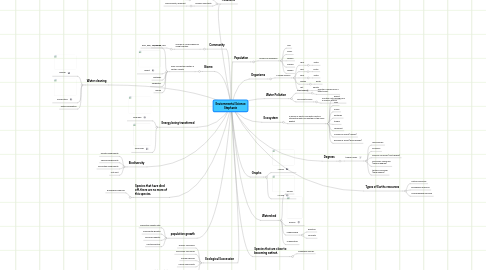
1. Community
1.1. Groups of living organisms living together.
1.1.1. bear, deer, fox, mouse, fern
2. Biome
2.1. many ecosystems within a certain climate
2.1.1. Savannah
2.1.2. desert
2.1.3. wetlands
2.1.4. freshwater
2.1.5. marine
3. Energy being transferred
3.1. food web
3.2. food chain
4. Biodiversity
4.1. Genetic Biodiversity
4.2. Species Biodiversity
4.3. Ecosystem Biodiversity
4.4. Hot spot
5. Species that have died off, there are no more of this species.
5.1. Endangered species
6. population growth
6.1. population growth rate
6.2. Exponential growth
6.3. Carrying capacity
6.4. Limiting factors
7. Ecological Succession
7.1. Primary Succesion
7.2. Secondary Succesion
7.3. Pioneer species
7.4. Climax community
7.5. Indicator species
7.5.1. species that show that an ecosystem is healthy.
8. Water cleaning
8.1. Aquifer
8.2. Desalination
8.3. Water purification
9. Pollutants
9.1. Inorganic Pollutants
9.1.1. oil, fertilizder, pesticide
9.2. Organic pollutants
9.2.1. animal waste, sediment
10. Organisms
10.1. A single lifeform
10.1.1. dear
10.1.1.1. biotic
10.1.2. fern
10.1.2.1. biotic
10.1.3. bear
10.1.3.1. biotic
10.1.4. human
10.1.4.1. biotic
10.1.5. dirt
10.1.5.1. abiotic
11. Population
11.1. Groups of organisms
11.1.1. fish
11.1.2. bears
11.1.3. wolves
11.1.4. buffalo
11.1.5. whales
12. Ecosystem
12.1. A group of abiotic and biotic factors interacting with one another in the same habitat
12.1.1. desert
12.1.2. river
12.1.3. ocean
12.1.4. wetlands
12.1.5. tundra
12.1.6. rainforest
12.1.7. coniferous forest (leaves)
12.1.8. deciduous forest (pine needles)
13. Degrees
13.1. trophic levels
13.1.1. decomposer
13.1.2. producer
13.1.3. primary consumer (first degree)
13.1.4. secondary consumer (second degree)
13.1.5. tertiary consumer (third degree)
14. Species that are close to becoming extinct.
14.1. Threatend species
15. Graphs
15.1. J curve
15.2. S curve
16. Water Pollution
16.1. Point source
16.1.1. Pollution coming from a direct point.
16.2. Non point source
16.2.1. Pollution not coming from a specific source.
17. Watershed
17.1. Runoff
17.2. erosion
17.3. impermeable
17.3.1. blacktop
17.3.2. concrete
